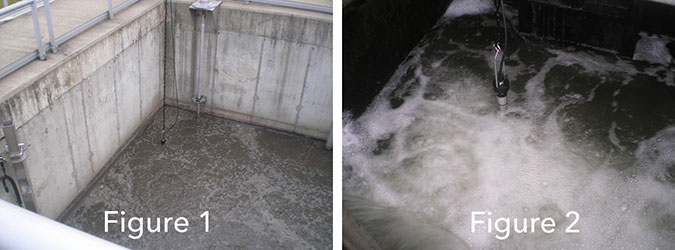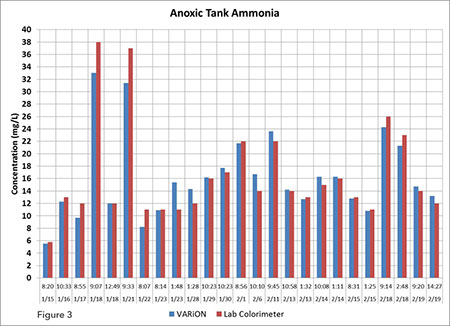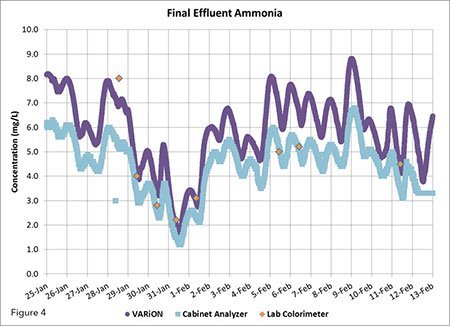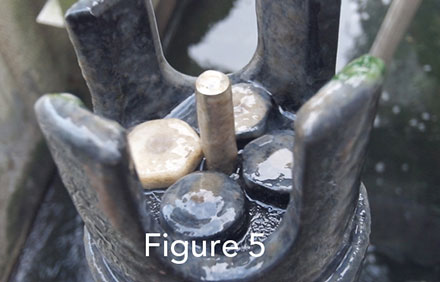Wastewater Nitrification and Denitrification Troubleshooting
The proper tools are essential to fix any problem. Over the years, Ohio EPA’s Compliance Assistance Unit (CAU) has helped dozens of water resource recovery facilities (WRRF) get back into and maintain compliance with National Pollutant Discharge Elimination System (NPDES) discharge permits.
Their field toolkit has included an assortment of batch sampling kits and handheld instruments. Each tool had its place but each also had limitations and, as a result, the compliance puzzle often was missing important pieces. Increasingly, as nutrient limits were incorporated into discharge permits, the missing piece was characterizing the dynamics of nitrification and denitrification. A new tool was needed with the following four features:
Continuous Monitoring
Continuous measurement with datalogging is essential to diagnosing problems. Batch tests on manual samples or laboratory measurements from grab samples provide a snapshot but do not provide insight into treatment dynamics. Furthermore, many problems occur overnight or on weekends when operators are not present to take measurements.
Simple
The tool needs to be simple and easy to understand. Many operators are part-time and most have additional responsibilities besides wastewater treatment. Tools that are overly complicated or require a lot of maintenance take time away from the operator to monitor treatment now and will eventually be neglected to eliminate the possibility for greater understanding of the process for the future.
Inexpensive
The tool needs to be inexpensive. It is important that the acquisition cost be comparable with other tools to fit into the budget. It is also important that ownership cost is low to not significantly increase the annual operating expenses. Furthermore, many wastewater facilities are small facilities serving institutions that also have a limited budget. Even better is a tool that pays for itself by enabling reduced O&M costs for energy or chemical inputs.
Versatile
Wastewater treatment requires balancing a number of concurrent reactions. Tools that enable simultaneous evaluation of multiple parameters to reduce the time required for troubleshooting and improve the result are highly desirable. The YSI IQ SensorNet has all the desired features and offered a reliable option for monitoring ammonium and nitrate with one instrument. The CAU equipment budget was limited so they needed proof of performance before placing an order.
YSI provided a trial system for them to evaluate and helped set up the system at the Millersburg, Ohio wastewater treatment plant. Two VARiON sensors were deployed, one in the anoxic basin (Figure 1) and the other in the final effluent channel (Figure 2). Each digital sensor was outfitted with ion selective electrodes (ISE) for ammonium, nitrate, and potassium in addition to a reference electrode and a temperature probe. An MIQ/Blue PS bluetooth module was utilized to connect the two measurement locations on the same network without the need for additional cabling.

Data retrieved from the Millersburg trial demonstrates the accuracy of the IQ SensorNet measuring system. A comparison of ammonium measurements recorded by the VARiON sensor and daily reference measurements made with a portable colorimeter from grab samples taken from the anoxic tank is shown in Figure 3. There is close agreement between the online measurements and the grab measurements in most cases. There was no attempt to determine which value was more correct during times that the values were relatively far apart.

VARiON measurements from the effluent location are compared with measurements from the existing cabinet analyzer and grab sample measurements in Figure 4. The VARiON and cabinet analyzer values trended closely although the VARiON reported values were generally higher by 0.5 to 2.0 mg /L. Laboratory analysis of grab measurements did not provide conclusive evidence that one method or the other is more accurate. Colorimeter measurements sometimes were in closer agreement with the VARiON and other times in closer agreement with the cabinet analyzer.

The IQ SensorNet proved its value to the OEPA CAU for monitoring nitrification and denitrification. Furthermore, maintenance also proved to be simple. A matrix adjustment was required for the ammonium, nitrate, and potassium electrodes at commissioning but the measuring accuracy remained stable thereafter without further adjustment. Fouling of the sensors will occur in wastewater environments.
Some accumulation was evident on the sensors used in this project (Figure 5)  after 6 weeks in anoxic bioreactor but the important observation was that the reliability of the measurement was not affected, even after six weeks continuous operation. The results of the trial led the CAU to order two VARiON sensors, a 2020 3G controller, and a Bluetooth set for simple set-up and communication at multiple measuring locations.
after 6 weeks in anoxic bioreactor but the important observation was that the reliability of the measurement was not affected, even after six weeks continuous operation. The results of the trial led the CAU to order two VARiON sensors, a 2020 3G controller, and a Bluetooth set for simple set-up and communication at multiple measuring locations.
The CAU has since deployed its system at multiple locations for troubleshooting nitrification/denitrification. The online measurements quickly identify and confirm problems saving time and increasing the productivity of the CAU. (Learn more, How to Control Denitrification Using Online Sensors).

Acknowledgements Jon van Dommelen, P.E. and Keith Kroeger of the Ohio EPA, Compliance Assistance Unit, for their evaluation of the effectiveness of the monitoring system and making their findings available for this article. Kevin Vaughn, Superintendent of the Millersburg WWTP and his very competent staff of professionals for serving as a test site and performing reference measurements.
Additional Blog Posts of Interest:
Shortcut the Nitrogen Removal Process in Wastewater with UV Sensors
Wastewater Process Control - Which Strategy is Right for You?
ORP Management in Wastewater as an Indicator of Process Efficiency
Myths and Realities: Ammonium Based Aeration Control in Wastewater